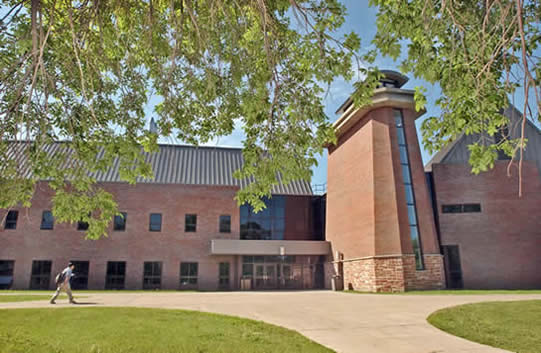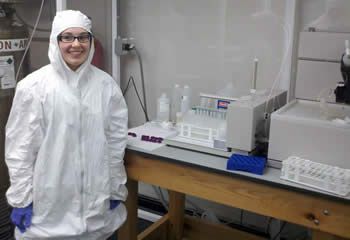Superior Analytics (formerly Environmental Analysis Laboratory) is housed in the College of Science and Environment at Lake Superior State University provides analysis services to state, federal, and local environmental monitoring programs emphasizing education, research, and community service. We follow US Environmental Protection Agency and MI Department of Environmental Quality approved analytical protocols on all analyses allowing data from the Environmental Analysis Laboratory to be included in appropriate state databases.
This laboratory provides students, staff, and faculty with the opportunity to collaborate with external agencies in research projects involving relevant environmental problems. We also provide the community with technical assistance for water quality analysis and monitoring, establishing a link between graduating seniors and potential employers.
The mission of LSSU Superior Analytics is to provide professional analytical and research services while engaging students in modern analytical techniques. Superior Analytics is designed to help students prepare themselves for careers as scientists, technicians, and other professionals by creating an environment where students work with highly trained staff to engage in research, design experiments, and perform sample analysis.
Superior Analytic’s organizational structure and Quality Assurance program is designed to effectively and efficiently accomplish established data quality objectives for all of its analytical services. The quality of measurements made by the laboratory is determined by the following data quality objectives or characteristics: representativeness, accuracy, and precision.
Specific objectives for each characteristic are generally established to assist in the selection of appropriate sampling and analytical protocols and to identify applicable documentation, sample handling procedures, and measurement system procedures. These quality objectives are established based on collection site conditions, specific requirements of the project, knowledge of available analytical systems, and are addressed whenever appropriate for the data generated.
The goal of Superior Analytics is to use the concept of complete quality management to produce analytical results of known, documented, and acceptable quality. The validity of data resulting from day-to-day analysis depends on a strong, effective, and consistently practiced quality assurance program. Superior Analytics’ Quality Assurance Manual (QAM) outlines that program for all aspects of laboratory chemical and microbiological testing operation. Superior Analytics’ objectives for precision, accuracy, and detectability of analytical results, and the associated quality control measures are described.
Superior Analytics’ quality assurance program is designed to be dynamic in nature. It currently encompasses activities for traditional wet chemical analysis techniques, classical and state-of-the-art instrumental analysis methods, and field measurements using portable analysis equipment. The program is designed to facilitate the fulfillment of both the Superior Analytics’ and the client’s goals for its analytical products. It also satisfies appropriate university, local, state, and federal regulatory requirements. The QAM is updated at a minimum annually, based on the results of quality assurance monitoring of analytical processes, internal and external assessments, and evolving regulatory policies.
Established in 2002, the Lake Superior State University Environmental Analysis Laboratory (EAL) was created to meet the analysis and research needs of Michigan’s Eastern Upper Peninsula. As the regions only full service environmental lab the EAL offers a wide range of analytical services to its clients including sample collection, inorganic and organic analysis in a variety of matrices, as well as genetic, microscopy & microanalysis, project design, and project implementation consultation.
Under the direction of LSSU faculty and staff the EAL offers undergraduate students internship opportunities within the lab. Student Interns are involved in all aspects of laboratory operation, affording them real hands on experience with not only the analytical side of a laboratory but also business side including data reporting and direct client interaction. The goal of these internships is to provide our students with a skill set allowing them to make a seamless transition to the workforce or graduate school. To date the EAL has employed nearly sixty students, all of which have moved on to become successful professionals.
Since its inception the EAL has matured into a fully-functioning analytical laboratory that allows students to gain hands on experience working on real projects with experienced faculty and staff. The combination of analytical services and practical education makes the LSSU EAL unique and allows the university to better serve its students and foster strong collaborations with both public and private sector partners.
Note: Volume discounts may apply. Additional discounts available for client prepared samples. Sample containers provided at no additional cost.
Instrumentation includes:
| Analysis | Sample/ Size |
| Anatoxin-a | Water / 0.01 L |
| Cylindrospermopsin | Water / 0.01 L |
| Microcystin | Water / 0.01 L |
| Saxitoxin | Water / 0.01 L |
Instrumentation includes:
| Analysis | Method | Sample/Size |
| Metals by MP-AES | SM 3111 | Water / 0.1 L |
| Metals by ICP/MS | EPA 6020 | Solids / l.0 g |
| Sample Digestion | Varies by Matrix | Solids / 1.0 g (dry) |
| Total Mercury | EPA 1631 E | Water / Solid |
Instrumentation includes:
Gas Chromatography
| Analysis | Method | Sample/Size |
| Organics by GC/FID | EPA 8015 C | Water / l.0 L |
| Organics by GC/MS | EPA 8270 D | Water / l.0 L |
| Organics by Purge and Trap GC/MS | EPA 8260 C | Water / l.0 L |
| Sample Extraction | Varies by Matrix | Water/Solids |
| Note: For available compounds please call. |
Instrumentation includes:

| Analysis | Method | Sample/Size |
| Alkalinity | SM 2320 B | Water/ 0.1 L |
| Ammonia | EPA 350.1 | Water/ 0.1 L |
| Anions (F, Cl, Br, NO2, NO3, o-PO4, and SO4) | EPA 300 | Water/ 0.1 L |
| Biological Oxygen Demand (BOD) | SM 5210 B | Water/ 0.1 L |
| Chlorophyll (a,b, & c) | SM 10200 H | Water/ l.0 L |
| Conductivity | SM 2510 B | Water/ 0.1 L |
| Enterococci (MPN) | SM 9230 D | Water/ 0.1 L |
| Hardness | SM 2340 B | Water/ 0.2 L |
| Nitrate | SM 4500 | Water/ 0.1 L |
| Nitrate + Nitrite | SM 4500 | Water/ 0.1 L |
| ortho-Phosphate | SM 4500P F | Water/ 0.2 L |
| pH | SM 4500H+ | Water/ 0.1 L |
| Silica | SM 4500-SiO2 D | Water/ 0.1 L |
| Total coliforrn/E coli (MPN) | SM 9223 | Water/ 0.l L |
| Total Dissolved Solids | SM 2540 C | Water/ 0.2 L |
| Total Kjeldahl Nitrogen | EPA 351.2 | Water/ 0.l L |
| Total Phosphorus | SM 4500P | Water/ 0.2 L |
| Total Suspended Solids | SM 2540 D | Water/ 0.2 L |
| Turbidity | EPA 180.1 |
Instrumentation includes:
qPCR
| Analysis | Method | Sample/Size |
| Enterococcus | EPA 1611 | Water / 0.5 L |
| Human Bacteroides | DRAFT EPA Method C | Water / 0.5 L |
Technical Assistance
Laboratory staff can provide technical assistance and water quality sampling equipment to volunteer monitoring programs. Please call (906) 635-2076 for more information, or email Ben Southwell at [email protected].
Location
Our facility is located in Room 342, Crawford Hall of Science at 650 W Easterday Ave, Sault Ste.Marie, MI.
Mailing Address:
Superior Analytics
Lake Superior State University
650 West Easterday Avenue
Shipping Address:
Superior Analytics
Lake Superior State University
1100 Merdian Street
Sault Ste. Marie, MI 49783
Sault Ste. Marie, MI 49783



